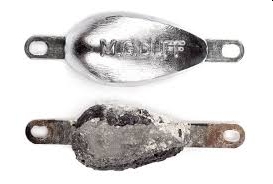Galvanic corrosion on boats is caused by a chemical reaction between the boat’s metalwork, and it’s surroundings. It’s "surroundings" can include...
-
- Other Boats
- Marina Pontoons
- Submerged metalwork
- Minerals in the Ground
This reaction creates a small electric Galvanic Corrosion Current which can dissolve metal from a boat’s hull. If your hull is GRP or wood, any underwater metalwork such as outboard motors, outdrives, propellers are at risk.
 There are three methods of preventing Galvanic corrosion. For best protection, use a combination of all three together. ALL are effective, but if you only do ONE thing, use a Galvanic isolator. It’s quick, easy, and inexpensive.
There are three methods of preventing Galvanic corrosion. For best protection, use a combination of all three together. ALL are effective, but if you only do ONE thing, use a Galvanic isolator. It’s quick, easy, and inexpensive.
Galvanic Isolation
If your boat is ever plugged into an electrical supply, Galvanic isolation is essential. Fit a Galvanic Isolator or isolation transformer. A Galvanic isolator safely breaks the electrical circuit that causes Galvanic corrosion - whilst letting the normal electric current flow, of course.
A Galvanic isolator should be fitted as standard equipment to all boats in all types of water. Marine Galvanic isolators are essentially the same as Galvanic isolators for fresh water, and the length/beam of your boat isn’t important. The same Galvanic isolator can protect all boat sizes, and the simplest way to achieve excellent Galvanic isolation is by using a plug in Galvanic isolator that simply connects to the end of the mains hook up cable. Wire in Galvanic isolators are also available for permanent installation.
Anodes
 To help control Galvanic corrosion, it’s normal to fit “Sacrificial anodes”, known as “Zincs” to your boat. The idea is that the anodes are of softer metal than the boat’s hull, so they corrode away first. In brackish or salt water, it’s better to use aluminium anodes, rather than zinc. Nevertheless, anodes DO corrode, and when they’re gone, the boat’s metalwork is again at risk.
To help control Galvanic corrosion, it’s normal to fit “Sacrificial anodes”, known as “Zincs” to your boat. The idea is that the anodes are of softer metal than the boat’s hull, so they corrode away first. In brackish or salt water, it’s better to use aluminium anodes, rather than zinc. Nevertheless, anodes DO corrode, and when they’re gone, the boat’s metalwork is again at risk.
When fitting anodes to your boat, ensure that you fit sufficient, and fit them in the appropriate places. Unless your boat is a small one, a couple of anodes front & back aren’t likely to be adequate. Take advice from an anode manufacturer before fitting. The manufacturer is likely to have better knowledge of it’s product than a chandler.
Coatings
The other thing you can do is to coat the boat’s metalwork. This stops oxygen from getting to the metal, and without oxygen, the corrosion can’t happen. Different metals and water types call for different coatings, but it’s crucial that the metal is extremely well prepared before application, and this will often mean grit blasting to bare metal to ensure good adhesion of the protection.
Simply painting over existing coatings isn’t good enough!
 It’s essential to maintain the coating in perfect condition, especially around the waterline, as even slight damage can let water get at the metalwork. Often, coatings can look perfect at first glance, but the metal underneath can be heavily corroded due to damage to the protection.
It’s essential to maintain the coating in perfect condition, especially around the waterline, as even slight damage can let water get at the metalwork. Often, coatings can look perfect at first glance, but the metal underneath can be heavily corroded due to damage to the protection.
Check coatings regularly with the boat out of the water, and especially after any sort of damage, scraping etc.
Bare in mind that if you have a steel hulled boat with an aluminium (or similar) outdrive, the soft metal of the outdrive can make it act as a sacrificial anode - which is why you often see outdrives and outboard legs so badly corroded.
Back to < FAQ >


